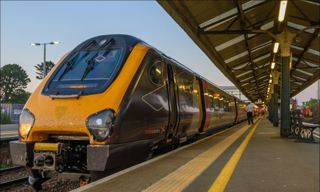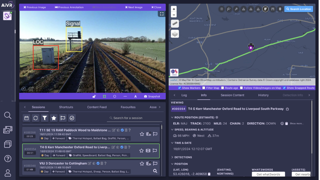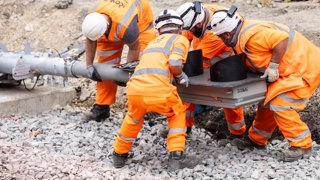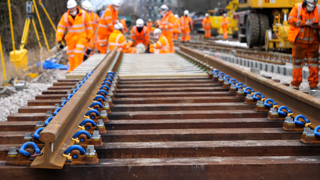“Putting passengers first” should not exclude other rail traffic from the narrative, says Maggie Simpson.
As I sat down to write this column, an email pinged into my inbox from the government’s daily update service, heralding “How the government is reforming the railways to put passengers first”.
“Putting passengers first” should not exclude other rail traffic from the narrative, says Maggie Simpson.
As I sat down to write this column, an email pinged into my inbox from the government’s daily update service, heralding “How the government is reforming the railways to put passengers first”.
Now, I do understand how to write an attention-grabbing headline, but I wonder if the Department for Transport is missing a trick by its persistent exclusion of freight from the narrative.
The update, a sensible and coherent statement given to Parliament on rail reform, set out a number of positive steps being taken in the passenger railway.
But it was totally silent on freight. It could, for example, have highlighted the very positive move to discount track access charges for new freight services, recently introduced by Network Rail. Surely Parliamentarians would see that as a positive action from the Secretary of State.
Putting passengers first also raises the obvious question of who is second, or third, or maybe even last? Freight users take your pick.
The Department is not unique in its approach. In Manchester, Mayor Andy Burnham has outlined how he “can’t wait” to get freight trains out of the city, citing performance benefits for passengers.
The scheme which he is promoting, to relocate part of the Trafford Park estate to a new location west of the city, has many merits for rail freight, offering significant new terminal capacity and opportunity. But it will take time and much private sector investment to develop, and it will not take all the freight out of the city - and nor should it.
These soundbites are, of course, designed to appeal to an audience of voters who quite reasonably want to see passenger rail services improve in their regions.
But the language that is used matters, and it is heard by audiences far and wide. It sets the tone and colours the debate in a way that is unhelpful. And it risks damaging investor confidence, and belief that the railways are a place where businesses should put their trade.
In my discussions with government, and with city regions and Combined Authorities across the country, I am confident in their support and commitment to rail freight and their desire to see it grow.
Taking HGVs off crowded roads, reducing carbon emissions and supporting trade are key priorities with almost universal support, and the underlying narrative for rail freight is hugely positive.
Government is committed to a rail freight growth target, building on that set by the last administration. And we have excellent support from colleagues at the DfT. So, it should be simple to align the public messages with this ambition.
The narrative is even more important in the run-up to the second Railways Bill, which is expected to wend its way through Parliament during the early part of 2025.
We have yet to see (at time of writing) the details of this Bill, but we do expect it to include more profound restructuring than the previous version, with the change from a ‘guiding’ to ‘directing’ mind, leading to greater legal changes and radical reform of railway rules and institutions. This is inevitable, and understandable when viewed through a passenger lens.
Merging Network Rail and the train operating companies (TOCs) into a single legal entity means that huge parts of the contractual structure can be deleted.
Station leases, for example, become a thing of the past. There is no real need for passenger track access charges, and the requirements around timetabling can all change with a Secretary of State who can direct the services they wish to see operate.
However, this doesn’t hold for any operations that will not be within Great British Railways, which includes freight, open access, charters, and many regional services such as London Overground and Transport for Wales.
In these cases, there will still need to be a regulated process for access and charges, with independent oversight and clear frameworks to protect investment.
At this stage, it is not clear how such a hybrid approach will work, and how the tensions between flexibility and certainty can be met. In particular, it will be important that any new regime cannot require existing freight trains to be removed from the network, recognising their importance in business supply chains.
Track access will therefore be a particularly important element of the new Bill, as we expect the existing legal frameworks will be deleted and replaced by new proposals.
Fortunately, a number of safeguards have been proposed, and it is to the credit of the government that it has continued to honour the ones that were promised in the original Williams-Shapps Plan for Rail as well as in the previous consultation document from the DfT.
This is based around a statutory duty for freight, a freight growth target, and a commitment to a strong central freight team at the heart of GBR.
Some elements of this should rightly be in the new bill, such as the statutory duty. But others are more likely to be in GBR’s licence, policies and structure, and we hope to see more details on this emerging in parallel with the draft bill. It is also unclear whether they will be sufficient against these more radical reforms.
One area we are watching is how new regional partnerships between GBR and mayoral and Combined Authorities might be established.
This is particularly complex with different devolution deals in different regions, and an already varied level of involvement in passenger rail across the city regions.
Some areas such as London and Liverpool already operate trains under contract. Some have ambitions to own and operate the rail infrastructure, such as Scotland and Wales, while others are looking for a greater role in service specification. We might therefore expect to see a patchwork of different arrangements emerging across the country.
For the passenger railway, this could be highly productive, bringing local empowerment and local funding into play, and increasing opportunities for multi-modal integration at a much greater scale.
For freight, however, it has the potential for far greater fragmentation and complexity, particularly given the parallel changes in how track access is managed.
As I mentioned previously, the majority of regional bodies do absolutely want a good outcome for freight, too. But they, like us, are unclear on how freight will be included in these deals.
We believe it will be essential that the freight growth target and the statutory duty on GBR for freight are reflected in any new partnership agreements, so that regional bodies are also incentivised and supported to help freight grow. The plans for track access reform will also need to protect freight paths into (and indeed through) city regions.
Alongside the uncertainty over regional partnerships, the future structure of GBR remains unclear. This is not surprising given the change of government, and the team at Shadow GBR will need time to consider what is the right structure going forward.
Previous operational designs had, of course, been built around keeping the TOC operating unit as a separate entity. But that is no longer necessary, or indeed desirable, as there is now no intention to relet franchises in future.
However, it is probably still fair to assume that the structure will be built out around the current Network Rail routes and regions, even if the lower-level structure is more integrated than before.
This will mean that the leadership of those units will be intimately acquainted with passenger performance and farebox in a way that current route directors are not.
In this mix, we also need to ensure they remain motivated to deliver for freight.
This will need a mixture of formal governance and incentives, built out around the freight growth target, as well as cultural leadership from the top which leaves leaders in no doubt over the importance of freight, and indeed other non-GBR operators.
This in turn will require the executives at the top of GBR to be held to account by government for their delivery on freight, as well as on their other objectives. Another reason why “putting passengers first” might be a dangerous narrative.
In the middle of this is the single freight team which will sit at the heart of GBR. We really welcome this, and the team that has already been established is showing what can be achieved with a focused and driven approach.
It will be essential that they can continue to bring leverage on the rest of GBR, but also that it is a positive relationship, not a fight.
The team has a key role in reaching out into the wider industry, to help support growth and bring new businesses onto rail, and they are already making good strides here. But they will need to be empowered to do this, and have support from across the business to bring new users onto rail.
Inevitably this detail will take time to develop, and we will need to be patient while government and shadow GBR bring their plans together.
We will be watching to ensure that freight remains at the forefront of their thinking, as well as in the draft bill and consultation.
And during this time, setting the tone and language to be positive for freight remains as important as ever for maintaining business confidence, and for making the case for freight growth.
Maggie Simpson is Director General of the Rail Freight Group.
Login to continue reading
Or register with RAIL to keep up-to-date with the latest news, insight and opinion.


















Login to comment
Comments
No comments have been made yet.